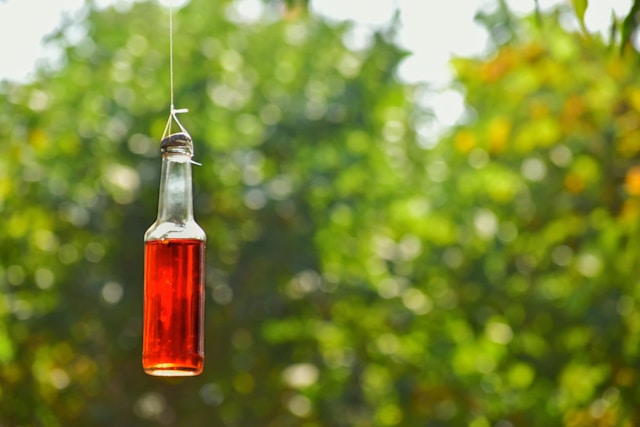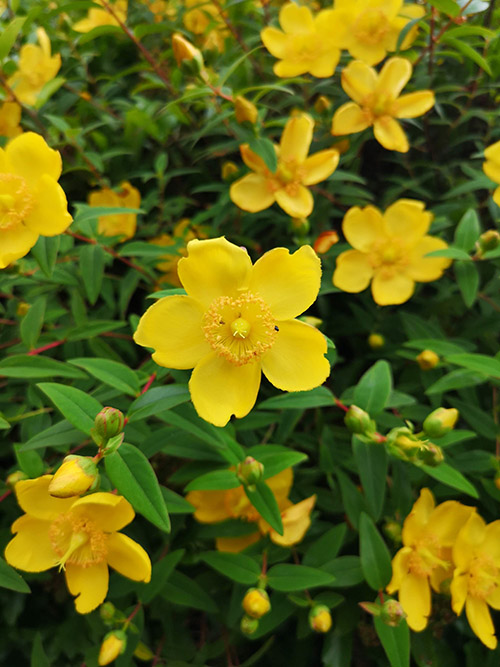One of the plants strongly associated with the summer solstice is St John’s Wort. It often flowers around Midsummer’s Day, or the Feast of St John, hence its strong links with St John.
St John’s Wort, or Hypericum Perforatum, is considered a weed in many places. Its other names include ‘balm of the warrior’s wound’, ‘rose of Sharon’, ‘Aaron’s beard’, and ‘sol terrestris’ (Baker 2011 [1969]: 140).
In the Victorian language of flowers, it meant both “animosity” and “superstition” (Burke 1867: 54).
Astrologer William Lilly attributes St John’s Wort to the Sun (1659: 71). Some writers say the flower was dedicated to solar god Baldur in Norse mythology (Baker 140).
But what does it have to do with Midsummer? Let’s find out!
Warding Off Evil
Christina Oakley Harrington calls St John’s wort one of the most important plants in European folk magic. It’s most often used for protection and shows up time and again in charms and rhymes to chase away evil spirits.
The name Hypericum comes from the belief you could ward off evil spirits with the plant because they found the scent obnoxious (Inkwright 2019: 143).
As an example, a poem explains that a woman used plants to guard a man from demonic attacks.
St John’s wort and fresh cyclamen she in her chamber kept
(Harrington 2020: 118)
From the power of evil angels to guard him while he slept
One of its old names is fuga daemonum, or devil’s flight (Harrington 2020: 118). According to folklore, neither the devil nor demons can be in the same room as anyone wearing St John’s wort.
You can also add it to a yellow charm bag to wear it around your neck for protection, or add it to a gold locket (Harrington 2020: 120).
When people burned St John’s Wort, it created an incense-like smell, believed to purify spaces (Binney 2018: 36). People used this when they had Midsummer bonfires. Tossing the plant into the flames added its scent to the smoke. People might jump through the smoke to protect themselves against evil (Binney 2018: 37). Doing so on 23 June was crucial since this was the night when people believed witches were abroad. People needed to protect themselves, their cattle, and their crops, ahead of the harvest.
People traditionally gathered the plant on Midsummer’s Eve, and Londoners would hang the plant all over their houses at midsummer. They also added vervain, mugwort, yarrow, elder, and male fern to their decorations for an added protective punch (Binney 2018: 37).
You could also gather St John’s Wort at midnight on St John’s Eve to hang over your doors, which stopped fairies coming into your house (Folkard 1884: 69).
Early Modern Folk Medicine
Remember, none of the herbal advice in this post is actual medical advice – it’s just folklore. Consult your physician if you have a health concern.
John Gerard suggested boiling the flowers and seeds and drinking the mixture to guard against bladder stones (1597: 433). He also recommends its leaves for use on burns, scalds, and other wounds.
Gerard also gives a recipe for making St John’s Blood. He recommends crushing the leaves, flowers, and seeds, and putting the mixture into a glass bottle with olive oil, before leaving it in the sun for a few weeks. Then you strained out the herbs, add the same amount of fresh plant material, and leave it in the sun again. He recommends this “oile of the colour of blood” for deep wounds, or “wounds made with a venomed weapon” (1597: 433).

He also gives another recipe which involves white wine, olive oil, turpentine, and St John’s Wort. This again is believed to cure any wound (1597: 433).
According to Dioscorides, drinking a mixture made from the seeds for forty days would cure sciatica and hip aches (1597: 433).
Other Folk Remedies
People believed it cured snakebite in Brazil, while in Russia they used it to cure hydrophobia. In Sicily, they used its oil and flowers to make a ‘balm for every wound’ (Baker 2011 [1969]: 140).
In the Netherlands, you could gather St John’s Wort before sunrise and use it to protect yourself against thunderstorms (Folkard 1884: xx).
People used St John’s Wort leaves as bookmarks as they believed the scent deterred paper mites (Inkwright 2019: 144). Putting the leaves into your shoes would stop you from tiring on long journeys (Baker 2011 [1969]: 141).
You could push St John’s Wort and thyme into a child’s mattress to ward off nightmares. People also believed that if you wanted to get pregnant, you should walk naked to pick the plant, and you would conceive within a year (Baker 2011 [1969]: 141).
While the plant is most effective if gathered at Midsummer, you could also gather it on Fridays during Jupiter’s hour to cure melancholy if you couldn’t wait (Harrington 2020: 118). Interestingly, people often use it as a supplement for its antidepressive properties, but you must check with your GP first as it contraindicates various medication, including the pill.
And as useful as St John’s Wort is, people believed it moved away from anyone who tried to pick it. If you stepped on it, a fairy horse would carry you away, taking you on a headlong dash, before dropping you off the following morning miles from your home (Baker 2011 [1969]: 140).
This might explain why it was considered unlucky to uproot St John’s Wort in Germany (Carruthers 1879: 52).
St John’s Wort and Love Magic
It also appeared in love divination. Red spots appear on the roots, supposedly on 27 August, the day of St John’s decapitation. Red patches also appeared on the leaves which would ‘bleed’ if your intended loved you. If they bled a colourless oil, the match was doomed (Baker 2011 [1969]: 141).
According to Miss Carruthers, young people in Brittany used St John’s Wort in a different way to prove if their lover was true. On St John’s Eve, the men and women went to a pillar stone or dolmen in the area. The men wore bunchs of green wheat and women wore flax blossoms. They danced around the stone before putting their wreath on it. If it remained fresh, they could trust their lover. If it shrivelled within a day or two, their love was doomed (1879: 17).
Richard Folkard relates a divination from Sweden, practised on St John’s Eve. Girls made a bouquet from nine flowers, which had to conspicuously include St John’s Wort. They gathered the flowers from nine different locations and put the bouquet under their pillow. She would then dream of her intended, who would soon enter her life (1884: 53).
In Lower Saxony, girls would put sprigs of St John’s Wort at the head of the bed or hang it on their walls. If it was fresh the next day, they’d marry within the year. If it dropped, they wouldn’t be successful (Folkard 1884: 537).
St John’s Blood
The oil from the plant is red, and has the rather Goth-friendly name of St John’s blood. Its most common uses involve warding off demonic attacks or curses. Many think the oil is the most potent if it’s extracted from plants gathered on Midsummer’s Day, and the plants need to be picked at midnight (Harrington 2020: 120).
The oil apparently gives you luck in gambling, or any other scenarios where you need to take a chance, like going to an auction. In Germany, people rubbed the oil on their bow or gun to help their marksmanship (Harrington 2020: 120). You might also rub it onto dice, if you’re at a casino, or yourself, to ward off bad luck.
What do we make of St John’s Wort?
So you can see this is a particularly potent time to gather and use St John’s wort, if you grow it, or know where to find it. The fact it’s considered a weed makes it a little easier to gather it.
Little of its folklore directly relates to St John, aside from the red spots appearing when he’s believed to have been beheaded. Instead, his name is used due to its flowering around his feast day. Its use to ward off evil no doubt comes through the association with St John the Baptist. That said, it could equally be powered by those solar associations.
Using it for home decoration on Midsummer’s Eve is an easy way to engage with the plant if it grows near you. You might prefer to try the love divination, and if you do, let me know how you get on!
References
Baker, Margaret (2011 [1969]), Discovering the Folklore of Plants, 3rd edition, Oxford: Shire Classics (aff link).
Binney, Ruth (2018), Plant Lore and Legend, Hassocks: Rydon (aff link).
Carruthers, Miss (1879), Flower lore; the teachings of flowers, historical, legendary, poetical & symbolical, London: George Bell & Sons.
Folkard, Richard (1884), Plant lore, legends, and lyrics: Embracing the myths, traditions, superstitions, and folk-lore of the plant kingdom, London: S. Low, Marston, Searle, and Rivington.
Gerard, John (1597), The Herball or Generall Historie of Plantes, London: John Norton.
Harrington, Christina Oakley (2020), The Treadwell’s Book of Plant Magic, London: Treadwells Books.
Inkwright, Fez (2020), Folk Magic and Healing: An Unusual History of Everyday Plants, London: Liminal 11 Press (aff link).
Lilly, William (1659), Christian Astrology, second edition, London: John Macock.
Nutty about folklore and want more?
Add your email below and get these posts in your inbox every week.
You'll also get my 5-step guide to protecting your home using folklore!











Have your say!